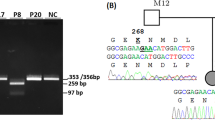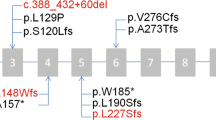Abstract
Primary ciliary dyskinesia (PCD) is a hereditary disease caused by pathogenic variants in genes associated with motile cilia. Some variants responsible for PCD are reported to be ethnic-specific or geographical-specific. To identify the responsible PCD variants of Japanese PCD patients, we performed next-generation sequencing of a panel of 32 PCD genes or whole-exome sequencing in 26 newly identified Japanese PCD families. We then combined their genetic data with those from 40 Japanese PCD families reported previously, for an overall analysis of 66 unrelated Japanese PCD families. We conducted Genome Aggregation Database and TogoVar database analyses to reveal the PCD genetic spectrum of the Japanese population and compare with other ethnic groups worldwide. We identified 22 unreported variants among the 31 patients in the 26 newly identified PCD families, including 17 deleterious variants estimated to cause lack of transcription or nonsense-mediated mRNA decay and 5 missense mutations. In all 76 PCD patients from the 66 Japanese families, we identified 53 variants on 141 alleles in total. Copy number variation in DRC1 is the most frequent variant in Japanese PCD patients, followed by DNAH5 c.9018C>T. We found 30 variants specific to the Japanese population, of which 22 are novel. Furthermore, 11 responsible variants in the Japanese PCD patients are common in East Asian populations, while some variants are more frequent in other ethnic groups. In conclusion, PCD is genetically heterogeneous between different ethnicities, and Japanese PCD patients have a characteristic genetic spectrum.
This is a preview of subscription content, access via your institution
Access options
Subscribe to this journal
Receive 12 print issues and online access
$259.00 per year
only $21.58 per issue
Buy this article
- Purchase on Springer Link
- Instant access to full article PDF
Prices may be subject to local taxes which are calculated during checkout




Similar content being viewed by others
References
Kennedy MP, Noone PG, Leigh MW, Zariwala MA, Minnix SL, Knowles MR, et al. High-resolution CT of patients with primary ciliary dyskinesia. AJR Am J Roentgenol. 2007;188:1232–8.
Moore A, Escudier E, Roger G, Tamalet A, Pelosse B, Marlin S, et al. RPGR is mutated in patients with a complex X linked phenotype combining primary ciliary dyskinesia and retinitis pigmentosa. J Med Genet. 2006;43:326–33. https://doi.org/10.1136/jmg.2005.034868.
Olcese C, Patel MP, Shoemark A, Kiviluoto S, Legendre M, Williams HJ, et al. X-linked primary ciliary dyskinesia due to mutations in the cytoplasmic axonemal dynein assembly factor PIH1D3. Nat Commun. 2017;8:14279.
Hannah WB, DeBrosse S, Kinghorn B, Strausbaugh S, Aitken ML, Rosenfeld M, et al. The expanding phenotype of OFD1-related disorders: Hemizygous loss-of-function variants in three patients with primary ciliary dyskinesia. Mol Genet Genom Med. 2019;7:e911 https://doi.org/10.1002/mgg3.911.
Wallmeier J, Frank D, Shoemark A, Nöthe-Menchen T, Cindric S, Olbrich H, et al. De Novo Mutations in FOXJ1 Result in a Motile Ciliopathy with Hydrocephalus and Randomization of Left/Right Body Asymmetry. Am J Hum Genet. 2019;105:1030–9. https://doi.org/10.1016/j.ajhg.2019.09.022.
Legendre M, Zaragosi LE, Mitchison HM. Motile cilia and airway disease. Semin Cell Dev Biol. 2021;110:19–33. https://doi.org/10.1016/j.semcdb.2020.11.007.
Zariwala MA, Leigh MW, Ceppa F, Kennedy MP, Noone PG, Carson JL, et al. Mutations of DNAI1 in primary ciliary dyskinesia: evidence of founder effect in a common mutation. Am J Respir Crit Care Med. 2006;174:858–66. https://doi.org/10.1164/rccm.200603-370OC.
Mabrouk I, Al-Harthi N, Mani R, Montantin G, Tissier S, Lagha R, et al. Combining RSPH9 founder mutation screening and next-generation sequencing analysis is efficient for primary ciliary dyskinesia diagnosis in Saudi patients. J Hum Genet. 2022;67:381–6. https://doi.org/10.1038/s10038-021-01006-9.
Takeuchi K, Xu Y, Kitano M, Chiyonobu K, Abo M, Ikegami K, et al. Copy number variation in DRC1 is the major cause of primary ciliary dyskinesia in the Japanese population. Mol Genet Genom Med. 2020;8:e1137 https://doi.org/10.1002/mgg3.1137.
Werner C, Lablans M, Ataian M, Raidt J, Wallmeier J, Große-Onnebrink J, et al. An international registry for primary ciliary dyskinesia. Eur Respir J. 2016;47:849–59.
Shoemark A, Boon M, Brochhausen C, Bukowy-Bieryllo Z, De Santi MM, Goggin P, et al. International consensus guideline for reporting transmission electron microscopy results in the diagnosis of primary ciliary dyskinesia (BEAT PCD TEM Criteria). Eur Respir J 2020;55:1900725.
Takeuchi K, Kitano M, Kiyotoshi H, Ikegami K, Ogawa S, Ikejiri M, et al. A targeted next-generation sequencing panel reveals novel mutations in Japanese patients with primary ciliary dyskinesia. Auris Nasus Larynx. 2018;45:585–91. https://doi.org/10.1016/j.anl.2017.09.007.
Kano G, Tsujii H, Takeuchi K, Nakatani K, Ikejiri M, Ogawa S, et al. Whole-exome sequencing identification of novel DNAH5 mutations in a young patient with primary ciliary dyskinesia. Mol Med Rep. 2016;14:5077–83. https://doi.org/10.3892/mmr.2016.5871.
TogoVar [Internet]. Tokyo: Japan Science and Technology Agency (Japan), National Bioscience Database Center; 2018 - [cited 2022 Jun 04]. Available from: https://togovar.biosciencedbc.jp.
Gudmundsson S, Karczewski KJ, Francioli LC, Tiao G, Cummings BB, Alföldi J, et al. Addendum: The mutational constraint spectrum quantified from variation in 141,456 humans. Nature. 2021;597:E3–E4. https://doi.org/10.1038/s41586-021-03758-y.
Richards S, Aziz N, Bale S, Bick D, Das S, Gastier-Foster J, et al. Standards and guidelines for the interpretation of sequence variants: a joint consensus recommendation of the American College of Medical Genetics and Genomics and the Association for Molecular Pathology. Genet Med. 2015;17:405–24.
Zariwala MA, Knowles MR, Leigh MW Primary Ciliary Dyskinesia. 2007 Jan 24 [Updated 2019 Dec 5]. In: Adam MP, Mirzaa GM, Pagon RA, et al., editors. GeneReviews® [Internet]. Seattle (WA): University of Washington, Seattle; 1993-2022. Available from: https://www.ncbi.nlm.nih.gov/books/NBK1122/.
Hannah WB, Seifert BA, Truty R, Zariwala MA, Ameel K, Zhao Y, et al. The global prevalence and ethnic heterogeneity of primary ciliary dyskinesia gene variants: a genetic database analysis. Lancet Respir Med. 2022;10:459–68. https://doi.org/10.1016/S2213-2600(21)00453-7.
Morimoto K, Hijikata M, Zariwala MA, Nykamp K, Inaba A, Guo TC, et al. Recurring large deletion in DRC1 (CCDC164) identified as causing primary ciliary dyskinesia in two Asian patients. Mol Genet Genom Med. 2019;7:e838 https://doi.org/10.1002/mgg3.838.
Keicho N, Hijikata M, Morimoto K, Homma S, Taguchi Y, Azuma A, et al. Primary ciliary dyskinesia caused by a large homozygous deletion including exons 1-4 of DRC1 in Japanese patients with recurrent sinopulmonary infection. Mol Genet Genom Med. 2020;8:e1033 https://doi.org/10.1002/mgg3.1033.
Fassad MR, Patel MP, Shoemark A, Cullup T, Hayward J, Dixon M, et al. Clinical utility of NGS diagnosis and disease stratification in a multiethnic primary ciliary dyskinesia cohort. J Med Genet. 2020;57:322–30. https://doi.org/10.1136/jmedgenet-2019-106501.
Kurokawa A, Kondo M, Honda N, Orimo M, Miyoshi A, Kobayashi F, et al. Analysis of the diagnosis of Japanese patients with primary ciliary dyskinesia using a conditional reprogramming culture. Respir Investig. 2022;60:407–17. https://doi.org/10.1016/j.resinv.2022.02.003.
Abo M, Takeuchi K, Ikejiri M, Ueno T, Yoneda T, Hara J, et al. Primary ciliary dyskinesia with CCDC39 variants displaying specific ciliary ultrastructure and movement concordant with the genotype: A case report. Respir Investig. 2022;60:725–8. https://doi.org/10.1016/j.resinv.2022.05.005.
Okamoto S, Mizumoto H, Asui L, Ikejiri M, Ogawa S, Takeuchi K, et al. A case of primary ciliary dyskinesia diagnosed at 3 months of age. Journal of Japan Society of Perinatal and Neonatal Medicine. 2022;58:346–52. https://doi.org/10.34456/jjspnm.58.2_346.
Feng G, Saso S, Sasano H, Xu Y, Takeuchi K. A novel homozygous mutation of GAS2L2 in two sisters with primary ciliary dyskinesia. Intern Med. 2022;61:2765–9. https://doi.org/10.2169/internalmedicine.8884-21.
Xu Y, Ogawa S, Adachi Y, Sone N, Gotoh S, Ikejiri M, et al. A pediatric case of primary ciliary dyskinesia caused by novel copy number variation in PIH1D3. Auris Nasus Larynx. 2022;49:893–7. https://doi.org/10.1016/j.anl.2021.03.012.
Takeuchi K, Xu Y, Ogawa S, Ikejiri M, Nakatani K, Gotoh S, et al. A pediatric case of productive cough caused by novel variants in DNAH9. Hum Genome Var. 2021;8:3.
Funding
This research was funded by JSPS Grants-in-Aid for Scientific Research (C) (Grant Numbers 16K11210, 19K09886 and 22K09665), and (B) 22H03077 from the Ministry of Education, Culture, Sports, Science, and Technology of Japan, the Takeda Science Foundation, the Society for Promotion of International Oto-Rhino[1]Laryngology (SPIO) SODA TOYOJI SPIO Research Grant Program 2021, and AMED (Grant Number JP19ek0109410).
Author information
Authors and Affiliations
Contributions
KT and YX designed and conceptualized the study. YX, GF, TY, and SM performed analysis and interpreted the data. MN, MI, and MT performed the experiments. YX drafted the manuscript. SG and KT reviewed the manuscript. KT acquired the funding. KT acts as guarantor and accepts full responsibility for the work and/or the conduct of the study, had access to the data, and controlled the decision to publish. All authors critically revised the manuscript, contributed significantly to this work and declared to meet the ICMJE criteria for authorship.
Corresponding author
Ethics declarations
Competing interests
The authors declare no competing interests.
Additional information
Publisher’s note Springer Nature remains neutral with regard to jurisdictional claims in published maps and institutional affiliations.
Rights and permissions
Springer Nature or its licensor (e.g. a society or other partner) holds exclusive rights to this article under a publishing agreement with the author(s) or other rightsholder(s); author self-archiving of the accepted manuscript version of this article is solely governed by the terms of such publishing agreement and applicable law.
About this article
Cite this article
Xu, Y., Feng, G., Yano, T. et al. Characteristic genetic spectrum of primary ciliary dyskinesia in Japanese patients and global ethnic heterogeneity: population-based genomic variation database analysis. J Hum Genet 68, 455–461 (2023). https://doi.org/10.1038/s10038-023-01142-4
Received:
Revised:
Accepted:
Published:
Issue Date:
DOI: https://doi.org/10.1038/s10038-023-01142-4
This article is cited by
-
The challenge of diagnosing primary ciliary dyskinesia: a commentary on various causative genes and their pathogenic variants
Journal of Human Genetics (2023)



